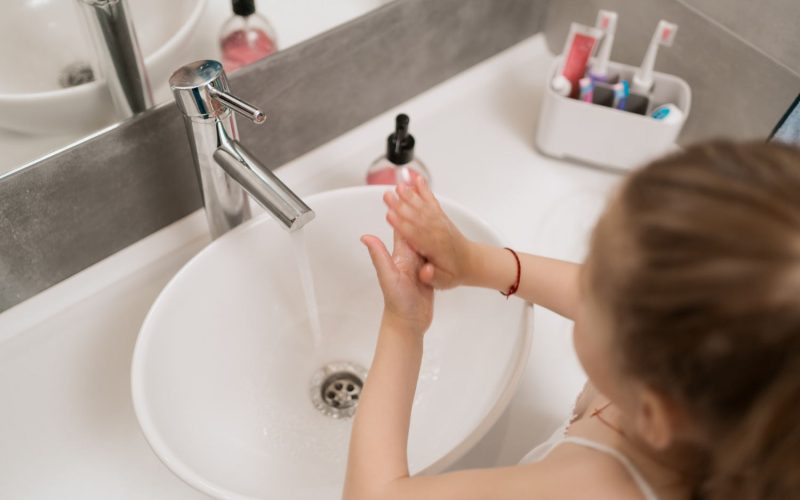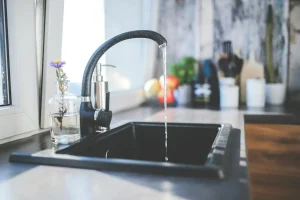Understanding the parts of a faucet, and knowing the names associated with bathroom faucet components, is crucial for maintenance and repair.
Read this guide to familiarize yourself with the key elements of how faucets work and some common problems each part is prone to.
Table of Contents
ToggleWhat Are the Parts of a Faucet Called
Faucet Spout
The part guiding water flow into the sink.
Common Problems: Mineral buildup or debris clogging the spout, causing irregular water flow.
Solutions: Regularly clean the spout with a mild solution, such as vinegar, to remove deposits.
Controls
Handles or levers for water control and temperature adjustment.
Common Problems: Loose handles, difficulty in turning, or issues with temperature control.
Solutions: Tighten loose handles and ensure proper installation. For temperature control problems, consider replacing the cartridge.
Aerator
Typically mesh-made, breaks water flow into streams, minimizing splashing and conserving water.
Common Problems: Clogging due to mineral deposits, affecting water flow.
Solutions: Remove and clean the aerator regularly. Soak it in a vinegar solution to dissolve stubborn deposits.
Valve
Modern faucets employ cartridge valves, encapsulating all vital parts in a replaceable unit.
Common Problems: Cartridge wear leads to leaks or malfunctions.
Solutions: Replace the cartridge if there are leaks or issues with water flow and temperature control.
Body
The central structure houses internal components.
Common Problems: Internal leaks or structural damage.
Solutions: Professional inspection may be required for internal issues. Ensure proper installation to prevent structural damage.
Mount
Attachment methods, like deck mount (connected to the sink) or wall mount.
Understanding these fundamental elements enhances knowledge of basin faucet mechanics, aiding in proper use and potential troubleshooting.
Common Problems: Loose mounting causing instability.
Solutions: Tighten mounting screws regularly. For wall-mounted faucets, ensure a secure and level installation.
Parts of a Bathroom Faucet: FAQs

What is the difference between a faucet cartridge and a faucet valve?
In a faucet, the valve manages water flow and temperature, with modern versions housed in a removable cartridge within the faucet body.
Valve wear occurs inside the cartridge, not the faucet body, making replacement simple. The valve comprises a movable stem attached to a handle and a fixed seat.
Pressing the moving part against the fixed part stops the water flow.
Meanwhile, the faucet cartridge, situated within the valve, regulates water flow as the handle turns it.
Can a faucet valve be replaced without replacing the cartridge?
The possibility of replacing a faucet valve without changing the cartridge hinges on the faucet’s design. Some integrated designs require proper cartridge seating for functionality.
Newer faucets with multiple “O” rings and seals secured by a nut or lock ring may pose challenges to address independently.
For these, replacing the valve may necessitate handling the cartridge simultaneously.
Conversely, older faucets with a simple valve stem and flat washer might allow valve replacement without changing the cartridge, albeit leading to water gushing out during the process.
Feasibility depends on the specific design and construction of the faucet.
How do you identify if a faucet valve needs to be replaced?
Detecting a need for faucet valve replacement involves noting specific signs.
A significant drop in water pressure may signal valve issues, as does the presence of rust, grime, or mineral deposits.
Persistent leaks or drips, even after addressing other components, could indicate a valve problem.
Visual inspection for corrosion, wear, or damage to valve components aids in identifying replacement needs.
Difficulty in fully shutting off water flow may suggest a faulty valve.
By observing these signs, one can assess whether the faucet valve demands replacement, ensuring the faucet’s optimal performance.
Key Takeaway
Understanding the key components of a faucet is essential for effective maintenance.
Regular inspection and prompt attention to signs such as poor water pressure, leaks, or corrosion can guide proper maintenance.
Replacing worn-out parts, particularly valves, and cartridges, ensures prolonged faucet functionality and water conservation.
In some cases, faucet manufacturers provide care instructions and installation procedures along with the product.




